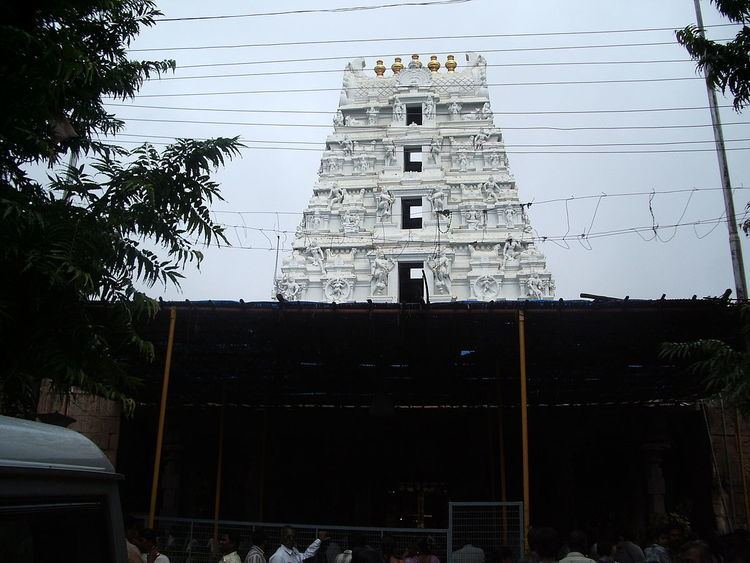Country India Primary deity Mallikarjuna (Shiva) Locale Srisailam | State/province Andhra Pradesh Phone 085242 88883 Important festival Maha Shivaratri | |
 | ||
Other names శ్రీ మల్లికార్జున స్వామి జ్యోతిర్లింగము Proper name Sri Mallikarjuna Jyotirlinga Temple Devanagari श्री मल्लिकार्जुन ज्योतिर्लिंग देवस्थान Address Srisaila Devasthanam, Srisailam, Andhra Pradesh 518101 Similar Nageshvara Jyotirlinga, Grishneshwar, Bhimashankar Temple, Omkareshwar, Baidyanath Temple | ||
Sri Mallikarjuna Swamy is a Hindu temple dedicated to the deity Shiva, located at Srisailam in South Indian state of Andhra Pradesh. It is significant to the Hindu sect of Saivism as one of the temples twelve Jyothirlinga shrines where Shiva is believed to have emanated as a pillar of fire. Shiva is worshiped as Mallikarjuna, and is represented by the lingam. His consort Parvati is depicted as Unnamulai Amman. The presiding deity is revered in the 7th century Tamil Saiva canonical work, the Tevaram, written by Tamil saint poets known as the nayanars and classified as Paadal Petra Sthalam.
Contents
The temple complex covers 2 hectares and houses four gateway towers known as gopurams. The temple has numerous shrines, with those of Mallikarjuna and Unnamulai Amman being the most prominent. The temple complex houses many halls; the most notable is the Mukha Mandapa built during the Vijayanagar period.
The temple has six daily rituals at various times from 5:30 a.m. to 10 p.m., and twelve yearly festivals on its calendar. The Shivratri festival is the most prominent festival of the temple. The present masonry structure was built during the Vijayanagar rulers of the Sangama Dynasty. The temple is maintained and administered by Chenchus with a jangama priest.
Jyotirlinga
As per Siva Mahapuranam, once Brahma (the Hindu God of creation) and Vishnu (the Hindu God of saving) had an argument in terms of supremacy of creation. To test them, Shiva pierced the three worlds as a huge endless pillar of light, the jyotirlinga. Vishnu and Brahma split their ways to downwards and upwards respectively to find the end of the light in either directions. Brahma lied that he found out the end, while Vishnu conceded his defeat. Shiva appeared as a second pillar of light and cursed Brahma that he would have no place in ceremonies while Vishnu would be worshipped till the end of eternity. The jyotirlinga is the supreme partless reality, out of which Shiva partly appears. The jyotirlinga shrines, thus are places where Shiva appeared as a fiery column of light. Originally there were believed to be 64 jyotirlingas while 12 of them are considered to be very auspicious and holy. Each of the twelve jyotirlinga sites take the name of the presiding deity - each considered different manifestation of Shiva. At all these sites, the primary image is lingam representing the beginningless and endless Stambha pillar, symbolizing the infinite nature of Shiva. The twelve jyotirlinga are Somnath in Gujarat, Mallikarjuna at Srisailam in Andhra Pradesh, Mahakaleswar at Ujjain in Madhya Pradesh, Omkareshwar in Madhya Pradesh, Kedarnath in Himalayas, Bhimashankar in Maharashtra, Viswanath at Varanasi in Uttar Pradesh, Triambakeshwar in Maharashtra, Vaidyanath at Deoghar district in [Jharkhand ], Nageswar at Dwarka in Gujarat, Rameshwar at Rameswaram in Tamil Nadu and Grishneshwar at Aurangabad in Maharashtra.
Legend
When Shiva and Parvati decided to find suitable brides for their sons, Ganesha and Kartikeya argued as to who is to get wedded first. Shiva bade that the one who goes round the world in Pradakshinam could get married first. By the time Kartikeya could go round the world on his vahana, Ganesha went round his parents 7 times (for according to Shastras, going in pradakshinam round one's parents is equivalent to going once round the world (Bhupradakshinam). Siva got Buddhi(intellect), Siddhi (spiritual power), and Riddhi (prosperity) married to Ganesha. kartikeya on his return was enraged and went away to stay alone on Mount Kravunja in the name of Kumarabrahmachari. On seeing his father coming over to pacify him, he tried to move to another place, but on the request of the Devas, stayed close by. The place where Siva and Parvati stayed came to be known as Shrishailam.
As per Hindu legend, the presiding deity in the form of Linga (an iconic form of Shiva) was worshipped with jasmine (locally called Mallika), leading to the name of presiding deity as Mallikarjuna.
Mahashivratri is the main festival celebrated at Srisailam Mallikarjuna Swamy temple.
History
The temple is situated facing East. The center mandapam has several pillars, with a huge idol of Nadikeshwara. The temple is enclosed by tall walls measuring 183 m (600 ft) by 152 m (499 ft) and 8.5 m (28 ft) tall. The are a number of sculptures in the precint each raising above another. There are inscriptional evidences from the Satvahana Dyanasty which place the temple to be existent from the 2nd century. Most modern additions were done during the time of king Harihara of Vijayanagara Empire. The Mukamandapa, the hall leading to the sanctum, has intricate sculpted pillars. The shrine where Mallikarjuna is housed is considered the oldest in the temple, dating back to 7th century. There is a Sahasra linga (100 linga), believed to have been commissioned by Rama and five other lingas belived to have been commissioned by Pandavas. A mirror hall in the first precinct has images of Nataraja. The temple is maintained and administered by Chenchus with a jangama priest.
Shakti Peeth
Srisailam Sri Mallikarjuna Swamy Temple is one of the 18 Maha Shakti Peetha. The mythology of Daksha yaga and Sati's self immolation resulted in the emergence of Sri Parvati in the place of Sati Devi and making Shiva a house holder. This mythology is the story behind the origin of Shakti Peethas. They are holy abodes of Adiparashakti formed due the falling of Sati Devi's corpse when Shiva carried it and wandered. It is believed that Sati Devi's Upper lip has fallen here.
